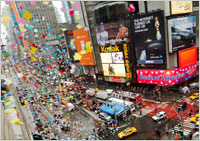|
|
|
 |
|
|
American Holidays > Other Celebrations |
|
Although the United States is young compared to other countries, its culture and traditions are rich because of the contributions made by the many groups of people who have come to its shores over the past two centuries. Hundreds of regional holidays have originated from the geography, climate and history of the different parts of the country. Each state holds its own annual fair with local themes and music; and some celebrate the day on which they joined the Union and became a state. One other day that most Americans observe, even though it is not an official holiday, is February 14, Valentine's Day, named for an early Christian martyr whose feast day was once observed on that day. On this day, Americans give special symbolic gifts to people they love. They also send special greeting cards called Valentines to such people. Most commonly, the gifts are candy or flowers. Other holidays such as "Groundhog Day" (February 2) are whimsically observed, at least in the media. The day is associated with folklore which has grown up in rural America. It is believed, by some, if the groundhog, or woodchuck comes out of its hole in the ground and sees its shadow on that day it will become frightened and jump back in. This means there will be at least six more weeks of winter. If it doesn't see its shadow, it will not be afraid and spring will begin shortly. Flag Day is observed in the United States to commemorate the adoption of the Stars and Stripes by the Continental Congress on June 14, 1777. Most of the celebrating of New Year's Day takes place the night before, when Americans gather in homes or restaurants or other public places to enjoy good food and to wish each other a happy and prosperous year ahead. Balloons and paper streamers, fire crackers and other noisemakers are all around at midnight when the old year passes away and the new year arrives. Thousands throng to the Times Square celebration in New York to count down to the New Year - a celebration that's carried live on TV networks across the U.S. |
||
| Feature Articles | ||
| Flag
Day: The Birthday of the Stars and Stripes
Times
Square a Focus of New Year's Eve Festivities For much of the past century, the neighborhood, centered on the intersection of Broadway, Seventh Avenue and 42nd Street, similarly has been reinvented time and again, but remained always a place where New Yorkers -- in the words of the social commentator and Romanian immigrant Andrei Codrescu, that "quick, witty, generous but not stupid breed of citizen" -- come to play.... |
||
| Texts
are abridged from U.S. State Department
IIP publications and other U.S. government materials. |
||
DISCLAIMER
Any reference obtained from this server to a specific commercial product, process, or service does not constitute or imply an endorsement by the United States Government of the product, process, or service, or its producer or provider. The views and opinions expressed in any referenced document do not necessarily state or reflect those of the United States Government. |
 U.S. Diplomatic Mission to Germany /Public Affairs/ Information Resource Centers Updated: September 2010 |

